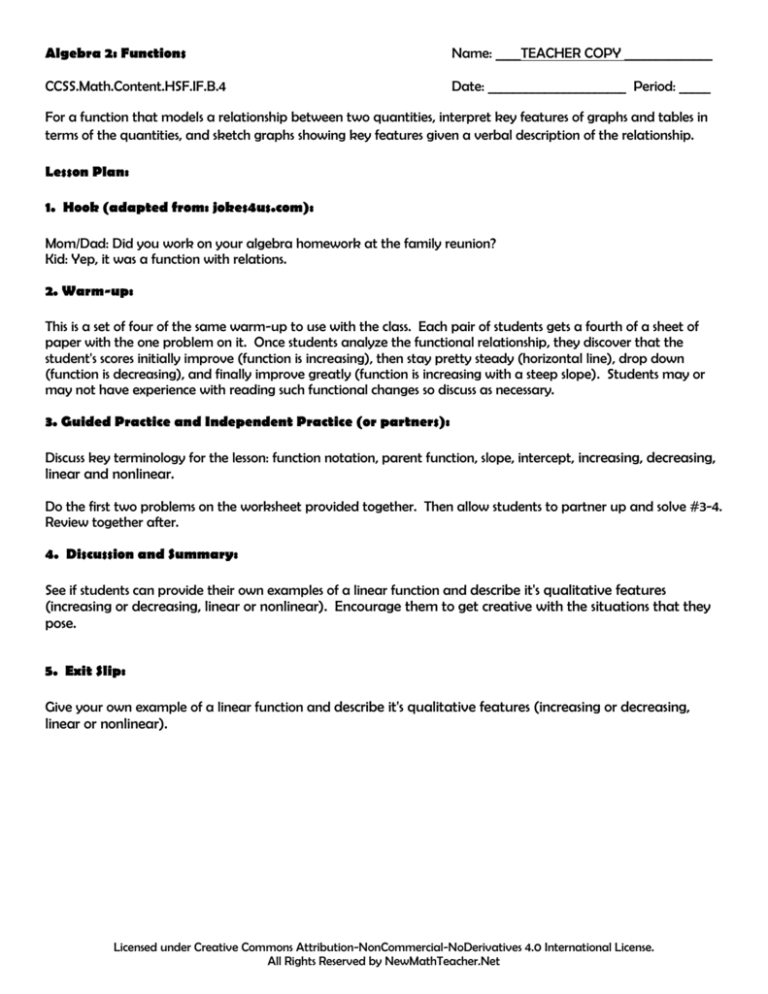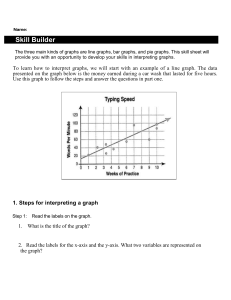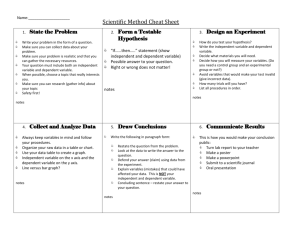
Algebra 2: Functions
Name: ____TEACHER COPY ______________
CCSS.Math.Content.HSF.IF.B.4
Date: ______________________ Period: _____
For a function that models a relationship between two quantities, interpret key features of graphs and tables in
terms of the quantities, and sketch graphs showing key features given a verbal description of the relationship.
Lesson Plan:
1. Hook (adapted from: jokes4us.com):
Mom/Dad: Did you work on your algebra homework at the family reunion?
Kid: Yep, it was a function with relations.
2. Warm-up:
This is a set of four of the same warm-up to use with the class. Each pair of students gets a fourth of a sheet of
paper with the one problem on it. Once students analyze the functional relationship, they discover that the
student's scores initially improve (function is increasing), then stay pretty steady (horizontal line), drop down
(function is decreasing), and finally improve greatly (function is increasing with a steep slope). Students may or
may not have experience with reading such functional changes so discuss as necessary.
3. Guided Practice and Independent Practice (or partners):
Discuss key terminology for the lesson: function notation, parent function, slope, intercept, increasing, decreasing,
linear and nonlinear.
Do the first two problems on the worksheet provided together. Then allow students to partner up and solve #3-4.
Review together after.
4. Discussion and Summary:
See if students can provide their own examples of a linear function and describe it's qualitative features
(increasing or decreasing, linear or nonlinear). Encourage them to get creative with the situations that they
pose.
5. Exit Slip:
Give your own example of a linear function and describe it's qualitative features (increasing or decreasing,
linear or nonlinear).
Licensed under Creative Commons Attribution-NonCommercial-NoDerivatives 4.0 International License.
All Rights Reserved by NewMathTeacher.Net
Partner Warm-up
Name: ________________
The graph below shows a student’s algebra grade over time.
The y-axis represents the student’s current score out of 100
(90% would be a 90) and the x-axis represents weeks.
Describe the student’s progress.
Name: ________________
The graph below shows a student’s algebra grade over time.
The y-axis represents the student’s current score out of 100
(90% would be a 90) and the x-axis represents weeks.
Describe the student’s progress.
100
100
60
60
20
20
Student’s progress:
Student’s progress:
Partner Warm-up
Name: ________________
The graph below shows a student’s algebra grade over time.
The y-axis represents the student’s current score out of 100
(90% would be a 90) and the x-axis represents weeks.
Describe the student’s progress.
Student’s progress:
Partner Warm-up
Partner Warm-up
Name: ________________
The graph below shows a student’s algebra grade over time.
The y-axis represents the student’s current score out of 100
(90% would be a 90) and the x-axis represents weeks.
Describe the student’s progress.
100
100
60
60
20
20
Student’s progress:
Licensed under Creative Commons Attribution-NonCommercial-NoDerivatives 4.0 International License.
All Rights Reserved by NewMathTeacher.Net
Basic Math: Functions
Name: __________________________________
CCSS.Math.Content.HSF.IF.B.4
Date: ______________________ Period: _____
For a function that models a relationship between two quantities, interpret key features of graphs and tables in
terms of the quantities, and sketch graphs showing key features given a verbal description of the relationship.
Analyzing Graphs using Function Notation
You have seen functions written in Slope-Intercept Form as y = mx + b. By naming the function, f, you can
write it using function notation as f(x) = mx + b.
The parent function (most basic function) of all linear equations is f(x) = x.
1. Using function notation to find a function’s value
What is the value of the function f(x) = 2x – 10 when x = 3?
2. Using function notation to find an x-value
For the function f(x) = 2x – 10, find the value of x so that f(x) = 6.
3. Graphing a function
Dr. Dallas Manson monitored the bobcat population in the San Jose
hills over several years for a project aimed at boosting the number of
bobcats. The number of bobcats can be modeled by the function
f(x) = 2x - 5 where x is the number of years since 2010. Graph the
function and describe it's qualitative features (increasing or decreasing,
linear or nonlinear).
4. Analyzing the Qualitative Features of a Function
Sketch a graph that shows the student’s algebra grade over time. The
y-axis represents the student’s current score out of 100 (90% would be
a 90) and the x-axis represents weeks.
On the first day of school, Sarah got a 90% on her diagnostic test. At
the end of week 1, Sarah got an 80% on her test. Then, for three
weeks, Sarah got 70% on each of her tests. Finally, at the end of week
5, she aced her test with a 100%.
Licensed under Creative Commons Attribution-NonCommercial-NoDerivatives 4.0 International License.
All Rights Reserved by NewMathTeacher.Net








